
Does your day start with a sense of dread? You look at your to-do list, a mountain of tasks that seems to grow taller overnight. Before you’ve even had your first sip of coffee, you already feel behind. This constant pressure, this feeling of never doing enough, is a heavy weight. It drains your energy, scatters your focus, and quietly chips away at your confidence. You work hard all day, juggling emails, meetings, and projects, only to end the day feeling like you accomplished nothing significant.
This experience is incredibly common, but it is not a personal failure. It’s a natural consequence of a system that is designed to measure what is lacking, not what has been achieved. The traditional to-do list is a tool of perpetual incompletion. It points only to the future, to the next thing, and the next. It offers no space to acknowledge the effort, the progress, and the small victories that make up your day.
What if there was a different way? A simple, gentle practice that could shift your entire perspective, boost your motivation, and help you cultivate a more positive mindset? There is. It’s called a “done list.”
Here at TheFocusedMethod.com, we believe that sustainable productivity isn’t about hustle or complex systems. It’s about understanding how your mind works and creating simple rituals that support your natural rhythms of attention. This guide will walk you through the power of the done list. We won’t just tell you what it is; we will show you how it works as a cornerstone for a focused, less stressful, and more fulfilling way of working and living. We will explore practical rituals, powerful thought tools, and the science behind why this small change can have such a profound impact on your focus and well-being.
📚 Table of Contents
- The Critical Difference: Done List vs To Do List
- Understanding Your Brain’s Attention Model
- Simple Rituals for Sustained Focus
- The Startup Ritual
- The Deep-Work Entry Ritual
- Break Hygiene
- The Shutdown Ritual
- Your 15-Minute Focus Starter Pack
- Powerful Thought Tools for a Resilient Mindset
- Reframe Perfectionism: From Perfect to Complete
- Reduce Friction: Make It Easy to Start
- Script Your Reset: A Compassionate Response to Derailment
- Worked Examples: The Done List in Action
- Frequently Asked Questions (FAQ)
- Is it better to work with music, white noise, or in silence?
- I feel like I get more done when I multitask. Is it really that bad?
- What should I do on days when I have absolutely no motivation to start?
- Should I use a done list for my personal life too?
- Your Seven-Day Challenge: Putting the Done List to Work

The Critical Difference: Done List vs To Do List
At first glance, a done list might sound like a simple inversion of a to-do list. While a to-do list is a forward-looking document of tasks you intend to complete, a done list is a backward-looking record of what you have already accomplished. The distinction seems minor, but the psychological impact is monumental. Understanding the core difference is the first step toward reclaiming your sense of control and accomplishment.
A to-do list operates on a principle of deficit. It is a catalogue of everything you haven’t done yet. Each unchecked box is a tiny, silent judgment. As you add more tasks, the list becomes a source of anxiety. It represents a gap between your current reality and a future, more productive version of yourself. This creates a constant, low-grade stress. Your brain interprets this endless list as a threat or a problem to be solved, keeping you in a state of reactive alert rather than calm, focused engagement.
A done list, in contrast, operates on a principle of surplus and evidence. It is a concrete, undeniable record of your effort and progress. Each item you add is a small celebration. It says, “I did this. This matters.” Instead of generating anxiety, it generates momentum. It taps into the brain’s reward system, releasing a small hit of dopamine with each acknowledged accomplishment. This positive feedback loop makes you want to do more, not because you have to, but because it feels good to see your progress accumulate.
Think about the mental energy involved. Managing a to-do list requires constant planning, prioritizing, and re-evaluating. This consumes valuable mental bandwidth. The done list requires only one thing: acknowledgement. You simply note what you just finished. It is an act of mindful presence, not frantic future-planning. This simplicity is its strength. It frees up your mind to focus on the task at hand, rather than the mountain of tasks yet to come.
Furthermore, the done list combats the brain’s natural negativity bias. Our minds are wired to pay more attention to problems, threats, and unfinished business. This is an ancient survival mechanism. It’s why at the end of a long day, you are more likely to remember the one frustrating email you didn’t answer than the ten important ones you did. The to-do list feeds this bias perfectly. The done list actively works against it. By intentionally recording your accomplishments, you are training your brain to see and value your contributions, fostering a more balanced and positive mindset.

Understanding Your Brain’s Attention Model
To truly appreciate why a done list and its associated rituals are so effective, it helps to understand a little about how your brain manages focus. Your ability to concentrate is not an infinite resource, nor is it a matter of willpower alone. It’s a biological process governed by specific limitations and patterns. When we work against these patterns, we feel overwhelmed. When we work with them, we can find a state of deep, effective focus.
Let’s define a few key concepts in simple terms.

Cognitive Load
Think of your working memory as your brain’s computer RAM. It’s the mental space you use for actively processing information, making decisions, and holding thoughts. Cognitive load is the total amount of mental effort being used in this working memory. When you try to juggle too many tasks, ideas, or pieces of information at once, you overload your RAM. Your brain slows down, you start making mistakes, and you feel mentally exhausted. A massive to-do list, a cluttered desk, and constant notifications all contribute to high cognitive load, leaving you with very little mental space for the actual work.

Context Switching
Every time you shift your attention from one unrelated task to another—like from writing a report to checking an email and then to answering a text message—you are performing a context switch. Many people believe they are multitasking, but neuroscience shows that the brain does not truly multitask on complex tasks. Instead, it switches rapidly between them. This switching is not free. It comes with a cognitive cost. It takes time and energy for your brain to disengage from the first task and load the context for the second. As institutions like the American Psychological Association (APA) have noted, even brief mental blocks created by shifting between tasks can cost as much as 40 percent of someone’s productive time.

Monotasking
The antidote to the high cost of context switching is monotasking. This is the simple, powerful practice of focusing on one single task for a dedicated period, without interruption. When you monotask, you allow your brain to fully engage. You reduce cognitive load because you are only holding the context for one activity in your working memory. This allows you to work more deeply, efficiently, and with far less stress. A done list supports monotasking by encouraging you to finish one thing and record it before moving on.

Flow State
When you are fully immersed in a single activity, feeling energized and focused, you might enter what is known as a flow state. In flow, your sense of time can distort, your self-consciousness fades, and the work itself feels rewarding. This is the peak of productivity and engagement. Achieving flow requires the right conditions: a clear goal, immediate feedback, and a task that is challenging but not overwhelming. Monotasking is the gateway to flow. By minimizing distractions and cognitive load, you create the mental environment where this profound state of focus can emerge.
Your energy for this kind of focused work is not constant throughout the day. It operates in cycles, known as ultradian rhythms. We can typically maintain high focus for about 90 minutes, followed by a period of about 20 minutes where our brain needs to rest and recover. Pushing through these natural lulls leads to burnout. Working with them—by taking strategic breaks—is the key to sustained performance.

Simple Rituals for Sustained Focus
Knowing the science is helpful, but putting it into practice is where the transformation happens. Rituals are powerful because they turn intention into automatic behavior. They reduce the need for willpower and decision-making, conserving your precious mental energy for your most important work. Here are four simple rituals, anchored by the philosophy of the done list, to help you structure your day for focus and a positive mindset.

The Startup Ritual
How you begin your day sets the tone for everything that follows. Instead of immediately diving into your inbox and letting other people’s priorities dictate your morning, a startup ritual creates a proactive foundation. This doesn’t need to be long or complicated. A simple startup ritual involves taking five minutes before you engage with any external demands. First, take a moment to look at your main goals for the day. Then, identify just one priority task. This isn’t your to-do list; it’s your “first win” list. What is the one thing that, if you complete it, will make you feel a sense of progress? Write that one thing down on a fresh piece of paper. This is your target. This clarity prevents the aimless drift that so often consumes the first hour of the day.

The Deep-Work Entry Ritual
Getting started on a challenging task is often the hardest part. A deep-work entry ritual is a short sequence of actions that signals to your brain that it’s time to focus. It’s like a warm-up for a mental workout. Your ritual could be as simple as this: clear your desk of everything except what you need for the task. Close all unnecessary browser tabs and applications. Put your phone on silent and place it out of sight. Set a timer for a specific period, perhaps just 25 minutes to start. Then, you begin work on the one priority task you identified in your startup ritual. This process reduces friction and overcomes the initial inertia. When the timer goes off, you will have made progress. You can then add that block of focused work to your done list.

Break Hygiene
The quality of your breaks is as important as the quality of your focus. Mindlessly scrolling through social media or news feeds is not a restorative break. It just bombards your brain with more information, increasing cognitive load. Good break hygiene means intentionally disconnecting. When your focus timer goes off, stand up. Stretch. Walk around the room. Get a glass of water. Look out a window at something distant to rest your eyes. The goal is to give your prefrontal cortex, the part of your brain responsible for executive function, a genuine rest. A five-minute real break will do more to restore your focus than a fifteen-minute digital “break.”

The Shutdown Ritual
Just as a startup ritual helps you begin your day with intention, a shutdown ritual helps you end it with a sense of completion. This is crucial for preventing work from bleeding into your personal time and for allowing your mind to fully recharge. Your shutdown ritual should be a clear, final act of the workday. First, take two minutes to write out your done list for the day. Look at everything you accomplished, big and small. Acknowledge your effort. Then, quickly plan your one priority for tomorrow. Finally, close all work-related tabs and say a simple phrase out loud, such as, “The workday is now complete.” This symbolic act creates a clean psychological break, signaling to your brain that it is safe to disengage and rest.

Your 15-Minute Focus Starter Pack
Feeling overwhelmed by new routines? Start small. Try this simple 15-minute routine once a day. Choose a small, single task. Clear your digital and physical workspace. Set a timer for 15 minutes and work only on that task. No email, no phone, no interruptions. When the timer rings, stop. Take a moment to write down what you just did on a piece of paper. That’s it. You’ve just monotasked, taken a tiny step, and started your first done list. Practice this once a day for a week. The feeling of small, focused wins will build momentum and confidence.

Powerful Thought Tools for a Resilient Mindset
The done list is a physical tool, but its greatest power is unlocked when combined with internal thought tools. These are simple mental shifts that help you navigate the inevitable challenges of distraction, procrastination, and self-doubt. They work hand-in-hand with your rituals to build a resilient and positive mindset.

Reframe Perfectionism: From Perfect to Complete
Perfectionism is a primary cause of procrastination. The fear that our work won’t be good enough can be so paralyzing that we never even start. We get stuck in an endless loop of planning, researching, and tweaking, but we avoid the crucial act of completion. The done list is a powerful antidote to this. It shifts the goal from “perfect” to “complete.”
Instead of focusing on an impossibly high standard, you focus on the simple, binary state of being done. Did you finish the first draft? Add it to the list. Did you send the email? Add it to the list. Did you spend 25 minutes focused on the project? Add it to the list. This practice trains you to value the act of finishing. It reminds you that progress is made through a series of completed, imperfect steps. You can always revise and improve later, but you can’t improve something that doesn’t exist. Celebrate completion first.

Reduce Friction: Make It Easy to Start
Our brains are wired to conserve energy, which means we naturally drift toward the path of least resistance. If starting a task feels difficult or complicated, we are more likely to avoid it. The key is to intentionally reduce the friction between you and the task. This can be done in many ways. You can use the “two-minute rule”: if a task takes less than two minutes, do it immediately. For larger tasks, identify the smallest possible first step that would take less than two minutes. For example, instead of “write the report,” the first step is “open a new document and write one sentence.”
Preparing your environment is another way to reduce friction. If you want to start your day by working on your priority project, get everything you need ready the night before. Open the necessary files. Lay out the relevant papers. When you sit down to work, there are no barriers. The easiest thing to do is to begin. The done list helps here by rewarding you for these small, friction-reducing actions, reinforcing the habit over time.

Script Your Reset: A Compassionate Response to Derailment
You will get distracted. You will fall off track. This is not a sign of failure; it is a normal part of being human. The crucial moment is not the distraction itself, but how you respond to it. Many of us respond with harsh self-criticism: “I can’t believe I just wasted 20 minutes on social media. I have no self-control.” This inner critic only adds a layer of shame, making it even harder to get back to work.
Instead, you need a pre-planned, compassionate reset script. This is a simple phrase you can say to yourself to gently guide your attention back without judgment. A good script has three parts: acknowledge, accept, and redirect. It might sound like this: “Okay, I just got distracted. That’s normal. I am now gently returning my focus to [name of the task].” Saying this to yourself, either internally or out loud, is a powerful act of self-regulation. It breaks the cycle of negative self-talk and makes it easy to resume your work. It is a moment of mindful awareness, not a moment of failure.

Worked Examples: The Done List in Action
Theory is useful, but seeing these principles applied to real-world situations makes them more tangible. Let’s explore two common scenarios where a done list and its associated mindset can make a significant difference.

Scenario 1: The Tight Deadline
Imagine Sarah, a project manager with a major report due in 48 hours. She feels a rising sense of panic. The project is huge, and looking at the entire scope is overwhelming. Her to-do list for it is a dozen items long, each one feeling like a mountain.
Instead of staring at the massive to-do list, Sarah decides to use a done list approach. She takes five minutes to break down the very first step into a tiny, manageable chunk: “Create the document outline.” She ignores everything else. She sets a timer for 30 minutes and works only on the outline. When the timer goes off, the outline is finished. She takes a clean sheet of paper and writes her first done list item: “Completed report outline.”
Seeing this first item provides a small jolt of positive reinforcement. The task no longer feels impossible. She then identifies the next small piece: “Write the executive summary draft.” She repeats the process. After another focused session, she adds it to her list. Throughout the day, she continues this cycle: identify a small chunk, work on it with singular focus, and then record its completion. By the end of the day, her done list has ten items on it. She can physically see her progress. The feeling of overwhelm has been replaced by a sense of momentum and control. She’s still on a tight deadline, but now she has concrete evidence that she is capable of meeting it.

Scenario 2: The Noisy Home Environment
Consider Ben, a freelance writer who works from home. His environment is often unpredictable, with family members, pets, and household noises creating constant potential for interruption. He struggles to find long, quiet blocks of time to write and often ends his day feeling frustrated and unproductive.
Ben realizes that waiting for the “perfect” quiet environment is a losing strategy. He decides to adapt using a done list mindset focused on small wins. He starts by identifying “micro-tasks” that can be done in short bursts. Instead of a goal like “write for two hours,” his goal becomes “write one solid paragraph.”
He uses a deep-work entry ritual to make the most of small windows of quiet. When he has 15 minutes, he puts on noise-canceling headphones, opens his writing app (and nothing else), and focuses solely on writing that one paragraph. When he’s done, or when he’s interrupted, he adds “Wrote one paragraph for the blog post” to his done list, which he keeps on a sticky note on his monitor. He also adds other small accomplishments, like “Answered the 3 most urgent client emails” or “Researched one statistic for the article.”
At the end of the day, his list isn’t filled with huge, impressive-sounding tasks. But it is filled. It’s a record of resilience. It shows him that even amidst the chaos, he made tangible progress. This shifts his mindset from “I got nothing done because it was so noisy” to “I managed to accomplish several important things despite the noise.” This builds his sense of effectiveness and reduces his frustration with his environment.

Frequently Asked Questions (FAQ)
As you begin to explore the done list and these related focus strategies, questions will naturally arise. Here are answers to some of the most common ones we hear at TheFocusedMethod.com.
Is it better to work with music, white noise, or in silence?
There is no single answer that works for everyone, as the ideal sound environment depends heavily on the individual and the type of task. For highly creative or complex work that involves language (like writing or coding), silence is often best, as lyrics and even complex melodies can interfere with the brain’s language processing centers. However, for more repetitive or mundane tasks, music can boost mood and motivation. White noise, pink noise, or ambient sounds (like a coffee shop soundscape) can be very effective at masking distracting background noises, helping you create a consistent and predictable sonic environment. The best approach is to experiment. Try different options for a 25-minute focus session and see how you feel and perform. The goal is to find what helps you enter a state of flow, not what someone else claims is “best.”
I feel like I get more done when I multitask. Is it really that bad?
This is a very common feeling, but it’s largely an illusion. What feels like productive multitasking is actually rapid context switching. Your brain is not running two complex tasks in parallel; it’s frantically jumping between them. While this might make you feel busy, the cognitive cost is high. Research from a wide range of sources, including studies referenced by organizations like the National Institutes of Health (NIH), consistently shows that this switching process leads to more errors, reduced comprehension, and higher stress levels. You may complete several things in a shallow way, but for work that requires deep thought, monotasking is significantly more effective and efficient. The feeling of “getting more done” often comes from the constant stimulation, not from genuine, high-quality output.
What should I do on days when I have absolutely no motivation to start?
Motivation is a fickle emotion; it often follows action, rather than preceding it. On days when you feel zero motivation, do not wait for it to appear. Instead, make the first action laughably small. Forget the big project. Your goal is simply to start for two minutes. Can you open the document? Can you write a single sentence? Can you put on your work shoes? The goal is to break the cycle of inertia with the smallest possible movement. Once you’ve completed that tiny action, add it to your done list. “Opened the file.” This can feel silly, but it’s a powerful psychological trick. It gives you an immediate micro-win and makes the next tiny step feel just a little bit easier. Build momentum from a place of zero, one tiny, acknowledged step at a time.
Should I use a done list for my personal life too?
You certainly can, and it can be very rewarding! Using a done list in the evenings or on weekends can help you appreciate the effort that goes into running a household, pursuing a hobby, or simply relaxing. It can be a wonderful tool for acknowledging things that often go unnoticed, like “Cooked a healthy meal,” “Spent 20 minutes reading,” or “Had a meaningful conversation with a friend.” However, a word of caution: be mindful of turning your personal life into another productivity exercise. The goal is not to optimize every moment but to appreciate it. Use the done list as a tool for gratitude and acknowledgement in your personal life, not as another checklist to conquer.

Your Seven-Day Challenge: Putting the Done List to Work
You have learned the why and the how. You understand the difference between a to-do list and a done list, the workings of your brain’s attention system, and the simple rituals that can anchor a focused day. Now, it is time to turn this knowledge into lived experience.
The biggest changes often start with the smallest, most consistent actions. We invite you to take on a simple, seven-day challenge. Don’t try to change everything at once. Just commit to these three small actions every workday for one week. The goal is not perfection; it is practice. The aim is to gather your own evidence about what works for you.
Your First Action: Create a Daily Done List.
For the next seven days, at the end of each workday, take five minutes with a simple notebook or a blank document. Write down everything you accomplished that day. Include the big tasks, the small ones, the meetings you attended, the difficult conversations you handled, and the focused work sessions you completed. Be specific. Don’t judge the items on the list. Just record them. This is your primary practice.
Your Second Action: Practice One 20-Minute Focus Block.
Once each day, choose one task. Just one. Set a timer for 20 minutes. For those 20 minutes, commit to monotasking. Close your other tabs. Put your phone out of sight. Give your full attention to that single task. When the timer goes off, stop. Add “Focused work for 20 minutes on [task]” to your done list. This will build your focus muscle and show you how much you can accomplish in a short, dedicated sprint.
Your Third Action: Implement a Two-Minute Shutdown Ritual.
At the very end of your workday, after you’ve completed your done list, perform a simple shutdown ritual. Close all your work-related browser tabs and applications. Tidy one small part of your desk. Then, say out loud, “My workday is done.” This small, symbolic act will help you create a clear boundary between work and rest, allowing you to more fully recharge for the day ahead.
That’s it. Three small commitments. Try them for a week. Observe how you feel. Notice the shift from a mindset of deficit to one of accomplishment. You have the power to reshape your relationship with your work, your focus, and yourself. It starts not with a grand overhaul, but with the gentle, consistent act of acknowledging what is already done.
Disclaimer: The information provided in this article is for educational and informational purposes only and is not intended as a substitute for professional medical or psychological advice, diagnosis, or treatment. Always seek the advice of your physician or other qualified health provider with any questions you may have regarding a medical condition or mental health concern.






